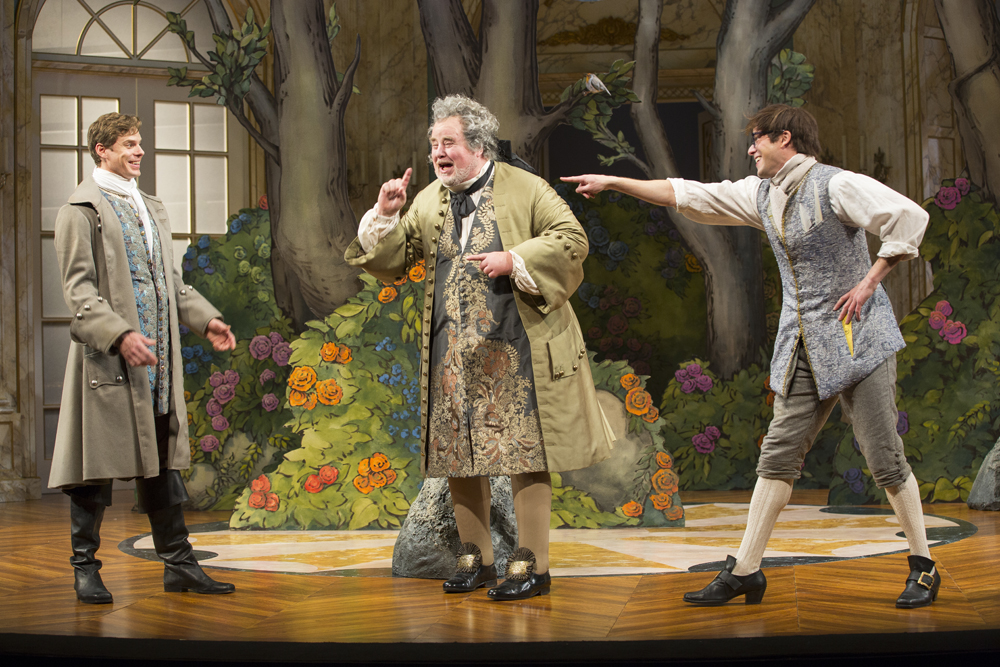Eyes on Ives: Designing French Comedy
The School for Lies is the fourth STC collaboration between Michael Kahn and David Ives. Starting back in 2010, the two translated and adapted Pierre Corneille’s 1644 comedy Le Menteur, producing the now-classic The Liar. A year later, the two tackled Jean-François Regnard’s 1709 La Légataire Universel to premiere the hilarious The Heir Apparent. Another four years passed before Kahn and Ives premiered The Metromaniacs, a “translaptation” of Alexis Piron’s 1738 play La Métromaine. Finally 2017 sees a reworking of Ives’s 2011 The School for Lies, an extensive overhaul of Molière’s famous 1666 Le Misanthrope.
Though billed as Kahn and Ives collaborations, these productions also joined together a world-class production design team that remained largely the same. Together for a fourth time, the design team has developed a short-hand for the look and feel of the productions. As The School for Lies runs at the Lansburgh Theatre through July 2, we look back on these collaborations and the gorgeous productions they’ve inspired.
For more on these plays and how they were created, read Ives and Kahn: Comedy Gold.
The Liar
Alexander Dodge (Set), Murell Horton (Costumes), Jeff Croiter (Lights), Adam Wernick (Music), Martin Desjardins (Sound)
Taking inspiration from the famed lifestyle and fashions made famous by Dumas’ The Three Musketeers, these looser-fitting gowns and doublets draped with short capes were all the rage during the reign of King Louis XIII. Juxtaposed against the trimmed and neat rectangles of Dodge’s set, these lavishly cascading fabrics romanticize the personalities within the confines of the strict social structures in place at the time.
- Miriam Silverman and Erin Partin in The Liar. Photo by Scott Suchman.
- Adam Green, Christian Conn and David Sabin in The Liar. Photo by Scott Suchman.
- The cast of The Liar. Photo by Scott Suchman.
The Heir Apparent
Alexander Dodge (Set), Murell Horton (Costumes), Philip Rosenberg (Lights), Adam Wernick (Music), Christopher Baine (Sound)
Infusing the insane with early 18th century French fashion, designs for The Heir Apparent were full of revelations. Locked boxes, chains and detritus were strewn about Dodge’s dark set, inspired by French sitting rooms and parlors, to suggest Geronte’s fanatic avarice and neglect, while Horton’s costumes contrasted in their bright and glamorous hues and contributed more than a few gags to the hilarity.
- Set rendering for The Heir Apparent by Alexander Dodge.
- Floyd King and Kelly Hutchinson in The Heir Apparent. Photo by Scott Suchman.
- Costume rendering for The Heir Apparent by Murell Horton.
- Nancy Robinette in The Heir Apparent. Photo by Scott Suchman.
- Costume rendering for The Heir Apparent by Murell Horton.
- Meg Chambers Steedle in The Heir Apparent. Photo by Scott Suchman.
The Metromaniacs
James Noone (Set), Murell Horton (Costumes), Mark McCullough (Lights), Adam Wernick (Music), Matt Tierney (Sound)
Like Ives did to Piron’s original verse, Horton adapted mid-18th century French fashion with modern silhouettes and lines to produce something completely new within the period’s structures. Poetry’s power is felt in Noone’s set design by once again bringing nature indoors and breaking up rigid geometric patterns.
- Anthony Roach and Amelia Pedlow in The Metromaniacs. Photo by Scott Suchman.
- Costume rendering for The Metromaniacs by Murell Horton.
- Anthony Roach, Adam LeFevre and Christian Conn in The Metromaniacs. Photo by Scott Suchman.
- Christian Conn in The Metromaniacs. Photo by Scott Suchman.
- Adam LeFevre and Dina Thomas in The Metromaniacs. Photo by Scott Suchman.
- Costume rendering for The Metromaniacs by Murell Horton.
The School for Lies
Alexander Dodge (Set), Murell Horton (Costumes), Mark McCullough (Lights), Adam Wernick (Music), Christopher Baine (Sound)
For The School for Lies, the design team worked to weave modern elements and artwork into the existing 17th century period stylization, resulting in sets and costumes that echo the period’s style but studded with contemporary surprises.
- Set rendering for The School for Lies by Alexander Dodge.
- Costume rendering for The School for Lies by Murell Horton.
- Costume rendering for The School for Lies by Murell Horton.



















